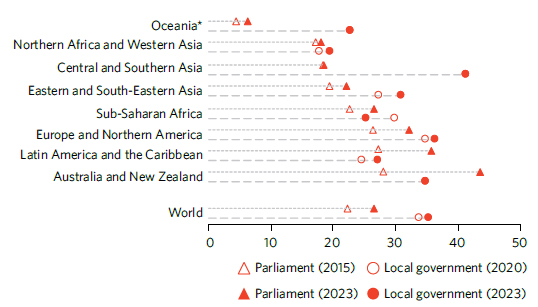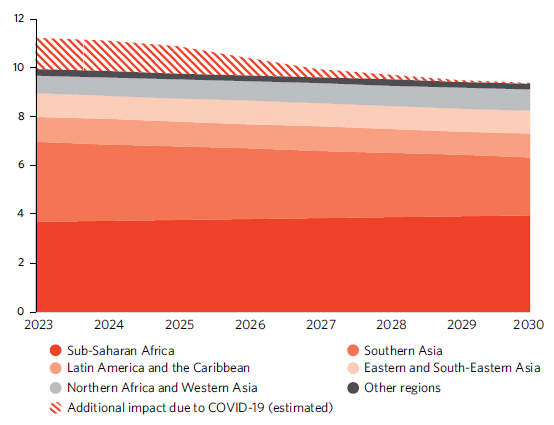Gender equality

Women from different social organizations participate in a march against gender violence in Quito, Ecuador.
© UN Women/Johis AlarcónGoal 5. Gender equality is a cross-cutting objective and must be a key focus of national policies, budgets and institutions.
Progress has been sluggish on upping women’s share in management and political representation
As of 1 January 2023, the global share of women in lower and single chambers of national parliaments reached 26.5 per cent – a slight improvement of 4.2 percentage points since 2015, but an average annual increase of just 0.5 points. At the local level, women held 35.5 per cent of seats in local governments in 2023, up from 33.9 per cent in 2020. If current trends continue, it will take more than four decades to close the gender gap in national parliamentary representation and three decades to do so at the local level. Legislated gender quotas have proven effective, with countries applying quotas seeing an average of 30.9 per cent women’s representation in the 2022 parliamentary elections, compared with 21.2 per cent in countries without quotas. Quotas also contribute to higher women’s representation in local government, by seven percentage points on average.
Globally, women accounted for nearly 40 per cent of total employment but held only 28.2 per cent of management positions in 2021. Progress on increasing women’s representation in management has been slow, with only a 1.0-percentage-point increase since 2015. At the current rate, it would take more than 140 years to achieve gender parity in managerial positions. Women’s representation in management remains below their share in total employment across all regions, with sub-Saharan Africa making the most progress, reaching 38.2 per cent in 2021. Conversely, Northern Africa and Western Asia, and Central and Southern Asia, have the lowest shares of women in management positions, at around 15 per cent, linked to low female employment rates in those regions.
Proportion of seats held by women in national parliaments and local governments (percentage)

*Excluding Australia and New Zealand.
Nearly half of married women lack decision-making power over their sexual and reproductive health and rights
Only 56 per cent of women aged 15 to 49 who are married or in a union are able to make decisions about their sexual and reproductive health and rights, according to data collected from 68 countries for the 2007–2022 period. Disparities exist among regions, ranging from 37 per cent in sub-Saharan Africa to over 80 per cent in some countries in Europe and Latin America and the Caribbean. While 89 per cent of women can decide to use contraception, one in four lack the autonomy to make health care decisions or to refuse sex.
Around 76 per cent of the 115 countries analysed have supportive laws and regulations guaranteeing full and equal access to sexual and reproductive health and rights. Barriers to accessing sexual and reproductive health care, information and education persist due to the lack of positive laws or the presence of negative ones, particularly in relation to abortion, the human papillomavirus (HPV) vaccine and sex education. Key components for ensuring sexual and reproductive health and rights laws include budget allocations, technical guidance, health worker training and public awareness-raising.
Insufficient progress has been made in reducing intimate partner violence over the past two decades
Despite growing global awareness and evidence on effective prevention strategies, progress on reducing violence against women and girls over the past two decades has been inadequate. Globally, in 2000, 35 per cent of ever-partnered women aged 15–49 had been subjected to physical and/or sexual violence by a male partner or ex-partner in their lifetimes and 16 per cent were subjected to this form of violence within the past 12 months. By 2018, these figures had dropped to 31 per cent of women for lifetime prevalence and 13 per cent for past-year prevalence. However, existing evidence suggests that violence against women was exacerbated by the pandemic. Without dedicated investment in scaling up prevention programmes, implementing effective policies and providing support services to address violence, countries will not achieve the target of eliminating violence against women and girls by 2030.
Discriminatory laws and gaps in legal protection persist in critical aspects, denying women their human rights worldwide
Data collected in 2022 from 119 countries reveal ongoing challenges for women in accessing their full human rights due to discriminatory laws and gaps in legal protection. An astonishing 55 per cent of countries lack laws that explicitly prohibit direct and indirect discrimination against women; 60 per cent lack laws that define rape based on the principle of consent. Another 45 per cent do not mandate equal remuneration for work of equal value, while more than a third of countries fail to provide maternity leave in accordance with International Labour Organization (ILO) standards. In terms of marriage and family, nearly a quarter of countries do not grant equal rights in marriage and divorce and close to three-quarters fail to establish 18 years as the minimum age of marriage for both women and men, without exceptions. Closing gaps in legal protections and removing discriminatory laws could take up to 286 years based on the current rate of change.
Recent gains are under threat in efforts to end child marriage
Today one in five young women (19 per cent) were married before their 18th birthday, compared with one in four (25 per cent) 25 years ago. Notable progress has been made in countries like Bangladesh, Ethiopia, India, Maldives and Rwanda. However, there has been little progress in areas of sub-Saharan Africa where child marriage is highest, and levels have remained stagnant in Latin America and the Caribbean. Furthermore, girls from the richest households are still much more likely to see progress than girls from the poorest households.
At the current pace, the world is at least 300 years away from ending child marriage and more than 9 million girls will still be married in the year 2030. Additional challenges related to the COVID-19 pandemic, conflicts and the impacts of climate change threaten to further hamper progress. Pandemic impacts alone are expected to result in an additional 10 million girls becoming child brides by 2030.
Projected number of girls under age 18 married per year, 2023–2030 projections (millions)

Note: “Other regions” include Europe and Northern America, Central Asia and Oceania.
Agricultural land ownership and legal protection of women’s land rights remain low
Available data from 46 countries for 2009–2020 show that many women and men involved in agricultural production lack ownership and/or secure tenure rights over agricultural land. In one third of these countries, less than 50 per cent of women and men have land ownership or secure rights. Meanwhile, in almost half of these countries, the share of men with ownership is at least twice that of women. When it comes to legal frameworks, close to 60 per cent of the 71 reporting countries have no or low levels of protection for women’s land rights. However, positive examples of laws and policies promoting women’s land rights exist in all regions, particularly in marital property and inheritance. Moreover, 51 per cent of the 41 countries with laws recognizing customary law or customary land tenure explicitly protect women’s land rights. Many also provide mandatory quotas to ensure women’s representation in land management and administration institutions. Nonetheless, there is a need for stronger protection, policies and enforcement of laws to safeguard women’s land rights.
Mobile phone ownership can be a powerful tool for empowering women, but gender parity remains elusive in many regions
Owning a mobile phone has been shown to be an important tool to empower women by connecting them to other people and enabling them to access information and services. Globally, 73 per cent of the population aged 10 and over owned a mobile phone in 2022, up from 67 per cent in 2019. However, women were 12 per cent less likely to own mobile phones than men, a gap that has remained relatively unchanged since 2019. Significant disparities exist across regions, with gender parity largely reached or almost reached in high- and middle-income regions, but far from achieved in lower-income regions. The gender gaps are twice as high (reaching around 25 per cent) in Central and Southern Asia and sub-Saharan Africa.

